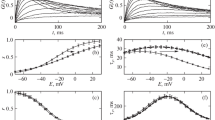Abstract
The mechanisms of transition from the rhythmic to bursting activity upon a change in the external stimulating current are investigated in the membrane model of a nociceptive neuron. It is found that the saddle-node bifurcation of the limit cycle in the structure of the bifurcation diagram of the fast subsystem and the torus bifurcation in the structure of the bifurcation diagram of the total system lead to the emergence of particular solutions of the torus canards type in these transitions. This confirms the assumption that torus canards-type solutions are a common feature in transitions between rhythmic activity and bursts.




Similar content being viewed by others
REFERENCES
R. Amir, M. Michaelis, and M. Devor, J. Neurosci. 22, 1187 (2002).
M. Devor, Exp. Brain Res. 196, 115 (2009).
E. P. Kostyuk, P. G. Kostyuk, and N. V. Voitenko, Neurophysiology 33, 303 (2001).
E. Goldin, J. Exp. Biol. 205, 575 (2000).
S. G. Waxman, T. R. Cummins, S. D. Dib-Hajj, et al., J. Rehabil. Res. Dev. 37, 517 (2000).
Y. Kovalsky, R. Amir, and M. Devor, J. Neurophysiol. 102, 1430 (2009).
K. Ishikawa, M. Tanaka, J. Black, et al., Muscle Nerve 22, 502 (1999).
B. Everill and J. D. Kocsis, J. Neurophysiol. 82, 700 (1999).
O. E. Dik, Tech. Phys. 64, 427 (2019).
O. E. Dick, B. V. Krylov, V. B. Plakhova, and A. D. Nozdrachev, Biophysics 63, 921 (2018).
M. A. Kramer, R. D. Traub, and N. J. Kopell, Phys. Rev. Lett. 101, 0681031 (2008).
M. Desroches, J. Guckenheimer, B. Krauskopf, et al., SIAM Rev. 54, 211 (2012).
J. Burke, M. Desroches, A. M. Barry, et al., J. Math. Neurosci. 2, 1 (2012).
M. Desroches, J. Burke, T. J. Kaper, et al., Phys. Rev. E 85, 0219201 (2012).
A. A. Elliott and J. R. Elliott, J. Physiol. 463, 39 (1993).
Y. A. Kuznetsov, Elements of Applied Bifurcation Theory (Springer, New York, 1995).
J. Rinzel and Y. S. Lee, Nonlinear Oscillations in Biology and Chemistry, Ed. by H. G. Othmer (Springer, New York, 1986).
A. Dhooge, W. Govaerts, Y. A. Kuznetsov, et al., MATCONT and CL MATCONT: Continuation Toolboxes in MATLAB (Utrecht Univ., 2006).
E. M. Izhikevich, Int. J. Bifurcation Chaos 10, 1171 (2000).
Funding
This study was supported by the Fundamental Research Program of the State Academies of Sciences for 2013–2020 (GP-14, part 64).
Author information
Authors and Affiliations
Corresponding author
Ethics declarations
The author claims that there are no conflicts of interest.
Additional information
Translated by N. Wadhwa
Rights and permissions
About this article
Cite this article
Dik, O.E. Mechanisms of Transition from the Rhythmic to Bursting Activity in the Nociceptive Neuron Model. Tech. Phys. 65, 479–484 (2020). https://doi.org/10.1134/S1063784220030056
Received:
Revised:
Accepted:
Published:
Issue Date:
DOI: https://doi.org/10.1134/S1063784220030056




